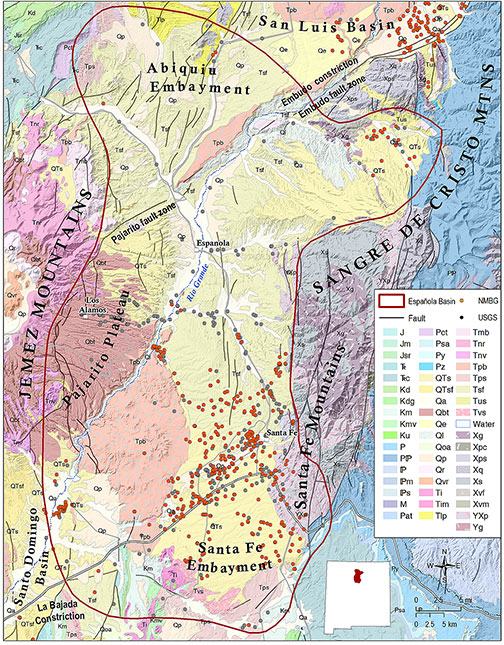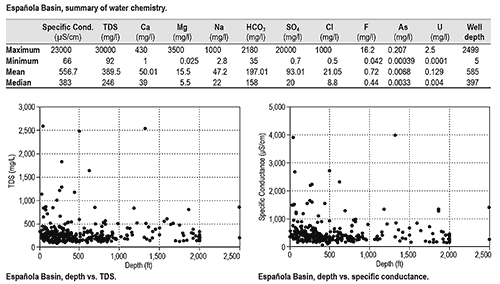
Overview of Fresh and Brackish Water Quality - Española Basin


The Española Basin is one of the northernmost basins of the Rio Grande Rift in New Mexico, and has been subject to extensive investigations in the past several decades (e.g., Kelley, 1978; Manley, 1979; Cordell, 1979; Golombek, 1983; Biehler et al., 1991; Johnson et al., 2008; Grauch et al., 2009). Although the Española Basin has the general form of a west-dipping half-graben, it exhibits a high level of structural complexity, consisting of a series of narrow, deep axial troughs in an otherwise shallow basin (Ferguson et al., 1995). The basin is ~50 miles long and 18 to 40 miles wide, and is linked to the east-dipping Santo Domingo Basin to the south at the La Bajada constriction. The basin is connected to the north with the east-dipping San Luis basin at the Embudo constriction. The Santa Fe Embayment occupies the southeast corner of the basin.
The Española Basin is bounded to the west by high-angle normal faults of the Pajarito fault zone. These faults are downthrown to the east and are covered by extrusive rocks of the Jemez Mountains volcanic field. The eastern margin of the basin is defined by the Santa Fe and Sangre de Cristo Mountains and is less structurally complex, characterized by a west-dipping Precambrian surface without major faulting. The SW-NE-trending Embudo fault zone extends obliquely across the basin, decoupling the main Española Basin to the south from the northern and northwestern parts of the basin, including the Abiquiu Embayment north of the Jemez Mountains (Kelley, 1976; Ferguson et al., 1995; Grauch et al., 2009).
Primary aquifers in the Española Basin are contained within the Tertiary-Quaternary Santa Fe Group. Basin-fill aquifers of the Santa Fe Group are the principal groundwater resource for the cities of Santa Fe, Española, and six Pueblo nations. The Santa Fe Group thickens to the west and north, ranging from ~250 feet thick south of Santa Fe to greater than 10,000 feet beneath the Pajarito Plateau west of Española (Grauch et al., 2009). The Tesuque Formation comprises the principal aquifer within the Santa Fe Group, and is in hydraulic communication with aquifers within the overlying Ancha and Puye Formations. The highly heterogeneous and complex nature of the Tesuque aquifer reflects its depositional environment of coalescing alluvial fans, a heterogeneity that is compounded by discontinuities created by faulting. The Santa Fe Group aquifers are in hydraulic communication with Precambrian rocks along the eastern margin of the basin where most of the recharge occurs. Paleozoic limestones underlying the basin-fill aquifers, fractured Tertiary intrusive rocks, and Tertiary volcanics of the Jemez volcanic field also locally produce water (Lewis and West, 1995; Grauch et al., 2009).
A substantial data set is available for the Española Basin, with 612 total data points. Ground-water in the Española Basin is generally of high quality (<1,000 mg/l TDS), but locally can be highly variable (Lewis and West, 1995; Johnson et al., 2008). Fault zones in the basin may focus upflow of warm, mineralized groundwater from deep regional aquifers that mixes with the shallow meteoric system. These upwelling geothermal waters degrade shallow water quality and create locally elevated levels of arsenic and other undesireable constituents (Johnson et al., 2008; 2013; Johnson, 2014). However, they also suggest the presence of brackish water resources of unknown volume at greater depths.
This phenomenon is reflected in the maximum, mean and median values for total dissolved solids in the Española Basin. A maximum TDS value of 30,000 mg/l was collected from one well on the southwest margin of the basin, but the basinwide mean and median values are <1,000 mg/l. Arsenic values similarly reflect the localized nature of elevated arsenic concentrations. Arsenic concentrations of 0.207 mg/l were measured in a well at the northern end of the basin, more than 20 times the EPA MCL of 0.01 mg/l. However, the basinwide mean and median arsenic concentrations are well below the MCL for that constituent.
This project is funded by the New Mexico Environment Department, Drinking Water Bureau, under Source Water Protection.
For more information:
see: Overview of Regional Brackish Water Assessments
or contact:
Lewis Land — Hydrogeologist, lland@nckri.org
References
- Land, Lewis, 2016, Overview of Fresh and Brackish Water Quality in New Mexico - Española Basin, Project Summary Sheet.
- Land, Lewis, 2016, Overview of Fresh and Brackish Water Quality in New Mexico, New Mexico Bureau of Geology Mineral Resources, Open-file Report, v. 0583, pp. 55.



